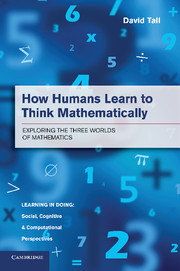Book contents
- Frontmatter
- Dedication
- Contents
- Series Foreword
- Journeys through three worlds of mathematics
- Preface
- Acknowledgements
- Illustration Credits
- I Prelude
- II School Mathematics and Its Consequences
- III Interlude
- IV University Mathematics and Beyond
- 10 The Transition to Formal Knowledge
- 11 Blending Ideas in the Calculus
- 12 Expert Thinking and Structure Theorems
- 13 Contemplating the Infinitely Large and Small
- 14 Expanding the Frontiers through Mathematical Research
- 15 Reflections
- Appendix Where It All Came From
- References
- Index
13 - Contemplating the Infinitely Large and Small
from IV - University Mathematics and Beyond
Published online by Cambridge University Press: 05 June 2014
- Frontmatter
- Dedication
- Contents
- Series Foreword
- Journeys through three worlds of mathematics
- Preface
- Acknowledgements
- Illustration Credits
- I Prelude
- II School Mathematics and Its Consequences
- III Interlude
- IV University Mathematics and Beyond
- 10 The Transition to Formal Knowledge
- 11 Blending Ideas in the Calculus
- 12 Expert Thinking and Structure Theorems
- 13 Contemplating the Infinitely Large and Small
- 14 Expanding the Frontiers through Mathematical Research
- 15 Reflections
- Appendix Where It All Came From
- References
- Index
Summary
As mathematics evolves, meanings change. In the late nineteenth century, Weierstrass reformulated the visual and dynamic ideas of the calculus as the formal limit concept: ‘Tell me how close you want the output (within epsilon) and I will tell you how close the input should be (within delta).’ This offered a replacement for the concept of an actual infinitesimal, by a potentially infinite process of becoming as small as is required. In essence this reaffirmed the potential infinity of Aristotle, reinterpreted using the modern quantified formulation of mathematical analysis.
Meanwhile, Cantor and Dedekind introduced the idea of completeness to fill out the rational number line to become the real number line. This ‘completeness’ is often interpreted to mean that there is ‘no room’ on the line for infinitesimals. It is not possible for a positive real number x to be smaller than all other positive real numbers because x/2 would also be a positive real number even smaller than x.
Cantor also contemplated the infinitely large, extending the concept of number to infinite sets by saying that two sets have the same cardinal number if they can be put in one-to-one correspondence. The cardinal number of natural numbers ℕ was named ℵ0 aleph zero). The sets ℕ, E, O of natural numbers, even numbers and odd numbers can be put in one-to-one correspondence by linking the natural number n to the even number 2n and the odd number 2n − 1. This reveals that the set of even numbers and the set of odd numbers also have the same cardinal number ℵ0.
- Type
- Chapter
- Information
- How Humans Learn to Think MathematicallyExploring the Three Worlds of Mathematics, pp. 361 - 385Publisher: Cambridge University PressPrint publication year: 2013



